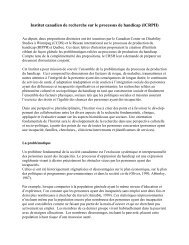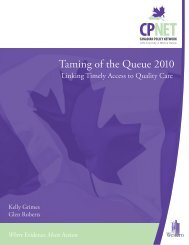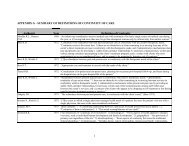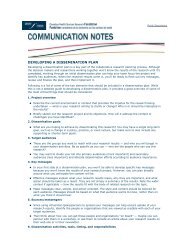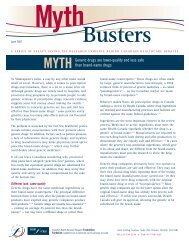Direct-to-consumer advertising is educational for patients
Direct-to-consumer advertising is educational for patients
Direct-to-consumer advertising is educational for patients
Create successful ePaper yourself
Turn your PDF publications into a flip-book with our unique Google optimized e-Paper software.
Other research evidence suggests prescription drug ads exaggerate<br />
benefits and downplay r<strong>is</strong>ks. It also finds that they<br />
don’t d<strong>is</strong>cuss non-drug treatments that may be available,<br />
prevalence of the illness or the success rate of the drug<br />
compared <strong>to</strong> a test group that <strong>to</strong>ok a placebo. By law,<br />
American ads must include in<strong>for</strong>mation about a drug’s<br />
side effects, who should and shouldn’t take the medicine,<br />
and overdoses. However, that in<strong>for</strong>mation <strong>is</strong> usually in small<br />
type in print ads, and TV ads often present the in<strong>for</strong>mation<br />
<strong>to</strong>o quickly <strong>to</strong> digest. xv-xviii<br />
Ask your doc<strong>to</strong>r<br />
Drug companies and their supporters argue that direct-<strong>to</strong><strong>consumer</strong><br />
ads start a conversation between <strong>patients</strong> and<br />
their doc<strong>to</strong>rs. Indeed, they do. And many of those <strong>patients</strong><br />
who ask their doc<strong>to</strong>r walk away with a prescription.<br />
The authors of a 2005 randomized trial in the U.S. found<br />
“standardized <strong>patients</strong>” — trained ac<strong>to</strong>rs pretending <strong>to</strong> be<br />
<strong>patients</strong> — who asked <strong>for</strong> an advert<strong>is</strong>ed drug were likely <strong>to</strong><br />
get a prescription <strong>for</strong> it, whether they showed symp<strong>to</strong>ms<br />
of the illness the drug treated or not. xix Meanwhile, doc<strong>to</strong>rs<br />
worry about spending their limited time “re-educating”<br />
<strong>patients</strong>, explaining why a certain drug <strong>is</strong>n’t appropriate<br />
xv, xviii<br />
<strong>for</strong> them or why a non-drug treatment may be better.<br />
Worth the cost?<br />
A 2007 study that compared spending on pharmaceutical<br />
drugs in the U.S. and Canada estimates that if Canada had<br />
followed the American lead in allowing these ads, it would<br />
be spending $10 billion more per year on prescription<br />
medicines than it currently does. xx<br />
Th<strong>is</strong> study, combined with a 2005 systematic review that<br />
found no evidence that direct-<strong>to</strong>-<strong>consumer</strong> <strong>advert<strong>is</strong>ing</strong><br />
leads <strong>to</strong> health benefits, xxi suggests the costs of opening the<br />
door <strong>to</strong> these less restrictive ads — both in dollars and r<strong>is</strong>ks<br />
— <strong>is</strong> not worth the possible benefits, unless they profiled<br />
appropriate and cost-effective treatments. xx<br />
Conclusion<br />
Manufacturers have put their faith in direct-<strong>to</strong>-<strong>consumer</strong><br />
<strong>advert<strong>is</strong>ing</strong>, spending $4.8 billion in the U.S. last year alone. xxii<br />
<strong>Direct</strong>-<strong>to</strong>-<strong>consumer</strong> <strong>advert<strong>is</strong>ing</strong> has proven effective in selling<br />
medicines and boosting profits, xxiii but not educating the<br />
public. To promote safe, effective and efficient medicine use,<br />
policy makers may be well-adv<strong>is</strong>ed <strong>to</strong> maintain restrictions<br />
on direct-<strong>to</strong>-<strong>consumer</strong> <strong>advert<strong>is</strong>ing</strong> and <strong>to</strong> invest in publicly<br />
sponsored campaigns — independent of manufacturers<br />
— that deliver reliable and comparative health in<strong>for</strong>mation<br />
<strong>to</strong> the public. xxiv<br />
References<br />
i. Brown B. 2004. “Opening the medicine cabinet: first report on health aspects of<br />
prescription drugs.” Report of the standing committee on health. http://cmte.parl.<br />
gc.ca/cmte/CommitteePublication.aspx?COM=8791&Lang=1&SourceId=76297<br />
ii. Gardner DM, Mintzes B, and Ostry A. 2003. “<strong>Direct</strong>-<strong>to</strong>-<strong>consumer</strong> prescription<br />
drug <strong>advert<strong>is</strong>ing</strong> in Canada: Perm<strong>is</strong>sion by default?”<br />
Canadian Medical Association Journal; 169(5): 425-427.<br />
iii. Health Canada. 2000 (updated 2005). “Advert<strong>is</strong>ing campaigns of branded and<br />
unbranded messages.” Policy Statement. www.hc-sc.gc.ca/dhp-mps/alt_<strong>for</strong>mats/<br />
hpfb-dgpsa/pdf/advert-publicit/advert-pub_camp_final_2005-08_e.pdf<br />
iv. Canada’s Research-Based Pharmaceutical Companies. 2007. “Position papers<br />
— Advert<strong>is</strong>ing prescription medicine in Canada: Why it makes sense.”<br />
www.canadapharma.org/Media/Papers/dtca_e.html (accessed March 3, 2007)<br />
v. Patented Medicine Prices Review Board. 2007. “Annual report.”<br />
www.pmprb-cepmb.gc.ca/CMFiles/PMPRB-AR06-en38FDK-7192007-4985.pdf<br />
vi. Donahue JM et al. 2007. “A decade of direct-<strong>to</strong>-<strong>consumer</strong> <strong>advert<strong>is</strong>ing</strong> of<br />
prescription drugs.” New England Journal of Medicine; 357: 673-681.<br />
vii. Mintzes B. 2006. “D<strong>is</strong>ease mongering in drug promotion: Do governments<br />
have a regula<strong>to</strong>ry role?” PLoS Medicine; 3(4): 0461-0465 (e198).<br />
viii. CBC. 2006. Canadian court halts generic Lipi<strong>to</strong>r launch: Pfizer.<br />
www.cbc.ca/money/s<strong>to</strong>ry/2006/12/08/pfizer.html<br />
ix. Therapeutics Initiative. 2003. “Do statins have a role in primary prevention?”<br />
Therapeutics Letter #48. www.ti.ubc.ca/PDF/48.pdf<br />
x. Frosch DL et al. 2007. “Creating demand <strong>for</strong> prescription drugs: A content analys<strong>is</strong><br />
of telev<strong>is</strong>ion direct-<strong>to</strong>-<strong>consumer</strong> <strong>advert<strong>is</strong>ing</strong>.” Annals of Family Medicine; 5(1):<br />
6-13.<br />
xi. Woloshin S and Scwartz LM. 2006. “Giving legs <strong>to</strong> restless legs: A case study<br />
of how the media helps make people sick.” PLoS Medicine; 3(4): 0452-0455<br />
(e170).<br />
xii. Merck & Co. 2004. “Merck announces voluntary worldwide withdrawal of<br />
Vioxx.” Press Release. www.vioxx.com/vioxx/documents/engl<strong>is</strong>h/vioxx_press_<br />
release.pdf.<br />
xiii. Mintzes B. 2006. “What are the public health implications? <strong>Direct</strong>-<strong>to</strong>-<strong>consumer</strong><br />
<strong>advert<strong>is</strong>ing</strong> of prescription drugs in Canada.” www.healthcouncilcanada.ca/docs/<br />
papers/2006/hcc_dtc-<strong>advert<strong>is</strong>ing</strong>_200601_e_v6.pdf<br />
xiv. IMS Health Canada. 2003. Compuscript.<br />
xv. Roth MS. 1996. “Patterns in direct-<strong>to</strong>-<strong>consumer</strong> prescription drug print<br />
<strong>advert<strong>is</strong>ing</strong> and their public policy implications.” Journal of Public Policy<br />
and Marketing; 15(1): 63-75.<br />
xvi. Woloshin S et al. 2001. “<strong>Direct</strong>-<strong>to</strong>-<strong>consumer</strong> advert<strong>is</strong>ements <strong>for</strong> prescription<br />
drugs: what are Americans being sold?” The Lancet; 358(9288): 1141-1146.<br />
xvii. Bell RA, Wilkes MS, and Kravitz RL. 2000. “The <strong>educational</strong> value of <strong>consumer</strong>targeted<br />
prescription drug print <strong>advert<strong>is</strong>ing</strong>.” Journal of Family Practice; 49(12):<br />
1092-1098.<br />
xviii. Lexchin J and Mintzes B. 2002. “<strong>Direct</strong>-<strong>to</strong>-<strong>consumer</strong> <strong>advert<strong>is</strong>ing</strong> of<br />
prescription drugs: the evidence says no.” Journal of Public Policy<br />
and Marketing; 21(2): 194-201.<br />
xix. Kravitz RL et al. 2005. “Influence of <strong>patients</strong>’ requests <strong>for</strong> direct-<strong>to</strong>-<strong>consumer</strong><br />
advert<strong>is</strong>ed antidepressants: A randomized controlled trial.” Journal of the<br />
American Medical Association; 293(16): 1995-2002.<br />
xx. Morgan SG. 2007. “<strong>Direct</strong>-<strong>to</strong>-<strong>consumer</strong> <strong>advert<strong>is</strong>ing</strong> and expenditures on<br />
prescription drugs: A compar<strong>is</strong>on of experiences in the United States<br />
and Canada.” Open Medicine; 1(1): e37-45.<br />
xxi. Gilbody S, Wilson P, and Watt I. 2005. “Benefits and harms of direct <strong>to</strong> <strong>consumer</strong><br />
<strong>advert<strong>is</strong>ing</strong>: A systematic review.” Quality and Safety in Healthcare; 14(4):<br />
246-250.<br />
xxii. Flood C and Zimmerman M. 2006. “<strong>Direct</strong>-<strong>to</strong>-<strong>consumer</strong> <strong>advert<strong>is</strong>ing</strong>: CanWest’s<br />
Charter Challenge.” In IHSPR Research Spotlight Pharmaceutical Research<br />
and Policy. www.cihr-irsc.gc.ca/e/32055.html<br />
xxiii. The Ka<strong>is</strong>er Family Foundation. 2003. “Impact of <strong>Direct</strong>-<strong>to</strong>-Consumer Advert<strong>is</strong>ing<br />
on Prescription Drug Spending.” www.kff.org/rxdrugs/upload/Impact-of-<strong>Direct</strong>-<strong>to</strong>-<br />
Consumer-Advert<strong>is</strong>ing-on-Prescription-Drug-Spending-Summary-of-Findings.pdf<br />
xxiv. Joint Declaration of HAI Europe, ISDB, AIM, BEUC, Medicines in Europe Forum.<br />
2006. “Relevant health in<strong>for</strong>mation <strong>for</strong> empowered citizens.”<br />
www.haiweb.org/01102006/PatientIn<strong>for</strong>mationDeclaration.pdf<br />
Myth Busters <strong>is</strong> prepared by knowledge transfer and exchange<br />
staff at the Canadian Health Services Research Foundation<br />
and publ<strong>is</strong>hed only after review by experts on the <strong>to</strong>pic.




